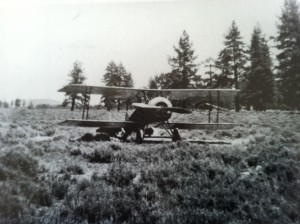

Big Bear City, CA January 25, 2014 – In 1916, Waldo Waterman, a pilot from Ontario, landed an aircraft in a field just east of Big Bear Lake, opening up a new era for the valley.
In 1924 Waterman laid out Big Bear’s first airfield just east of the lake. He used a 5 seat, single engine plane to provide passenger service between Ontario and the Big Bear Valley. There were some bumps along the way, however. Several local dignitaries went down to Ontario to make the maiden flight with Waterman. Unfortunately, they encountered turbulence which forced them to make a landing on a dry lake bed in Lucerne and they ended up hitching a ride home. A week later, the flight was made again with none of the original passengers. It made a successful trip up, landing safely in Big Bear. It then reloaded and took off again, only to stall at 300 feet and fall into the lake. The plane was destroyed and one passenger died of a heart attack, but the rest on board were relatively unhurt. Waterman put his plane back together and was back in business one month later. The airfield caught on.
In addition to Waterman’s regular flights, many days saw a half dozen airplanes on the field. In 1927, the field was re-graded for Ambassador Airways. Major Henry ‘Hap’ Arnold, who gained fame as an Army Air Corps commander in WWII, discovered Big Bear in the 30s and put pontoons on some of his planes in order to land and take-off on the lake. He loved Big Bear so much, he built a rest camp between Pine Knot and Moonridge which is now a US Marine Corps Air Station recreation facility.
Over the years, the field has gradually grown to over 5800 feet in length, houses over 150 aircraft, and on a busy Saturday sees more than 50 aircraft take-off and land. Big Bear City Airport has also become a very important staging area for aerial fire suppression in the San Bernardino Mountains.


